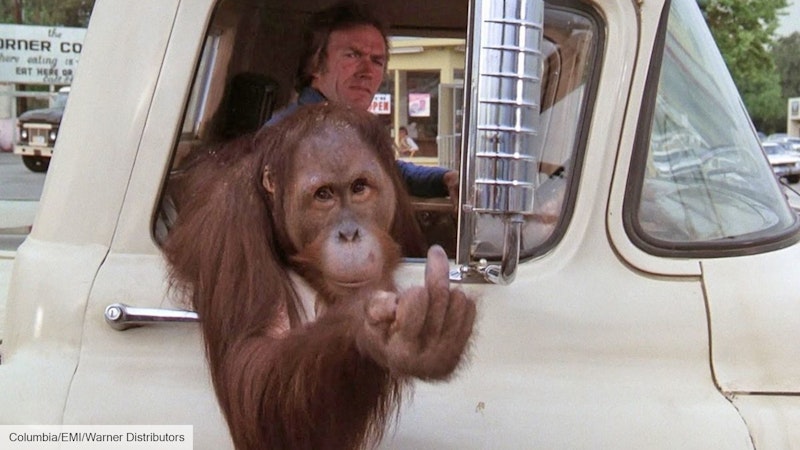It’s the late-1970s, and trucking through the motel-dotted highways of California’s Inland Empire are Philo Beddoe (Clint Eastwood) and his orangutan best friend, Clyde. Philo, like any blue-collar man, sells his body, although not in the most honest-days-work kinda way—he’s one of the best bare-knuckle boxers in town. He might tell people it's just to get by, but it’s just as much a way of finding freedom. If cowboys found it on the prairie, or his contemporaries find it on the open road, Philo fights for his way of life physically, with his bare hands; in fact, his orangutan came out of a fight. He explains to Lynn (Sondra Locke), his off-and-on-again country singin’ girl, that he couldn’t stand to see this monkey all locked up, so he bet the fight on Clyde’s freedom.
Philo has a human best friend too: Orville (Jeffrey Lewis) makes ends meet by impersonating tow companies and selling cars for scrap—with the help of Clyde, who can rip up a sedan like tinfoil. It’s not always fun for the trio, and they have some trouble with the law, whether it’s for their rough and rowdy ways or because they beat the department’s best puncher and ran off with the winnings. It’s not just highway patrolmen they gotta keep an eye out for: early in the first film, they get on the wrong side of a bumbling Nazi biker gang who tail Philo and provide some of the most outrageous slapstick in these two movies. At one point, they go looking for where he lives, but they aren’t ready for Ma (the wonderful Ruth Gordon) to pull out a shotgun and blast through their bikes like they were made by a Hollywood special effects team.
These movies aren’t remembered for any of this—they’re remembered for the monkey. Clyde throws back beers, has a mean right hook, and Philo even breaks him into the zoo just to get him laid. Clyde’s a very good monkey—or, two monkeys. Manis the orangutan starred as Clyde in the first movie, Every Which Way But Loose, but the young ape had grown too big by the time the sequel, Any Which Way You Can, was ready to shoot, and he was replaced by an uncredited primate. Why didn’t the series continue into the commercialized sequel factory of the 1980s?
Jane Goodall did some investigative work into the films’ animal rights issues and found that Manis’ stand-in for Any Which Way You Can was an orangutan named Buddha, who, in captivity, suffered severe abuse at the hands of his trainer. Not unlike the character he plays, Buddha had a “discipline problem,” but it's a lot less fun in the real world than the magical fantasy of the movies where the monkey can shit in a cop car and ride off into the sunset (or in Buddha’s case, steal donuts from craft services). Shortly before Any Which Way You Can wrapped shooting, Buddha was found dead in his cage, likely from internal hemorrhaging caused by sustained beatings from his trainer.
They don’t make ‘em like they used to, for better and worse. Terrible events of the past can’t be changed, so we have the dream world of movies to help us imagine a brighter possibility for human-primate relationships.

